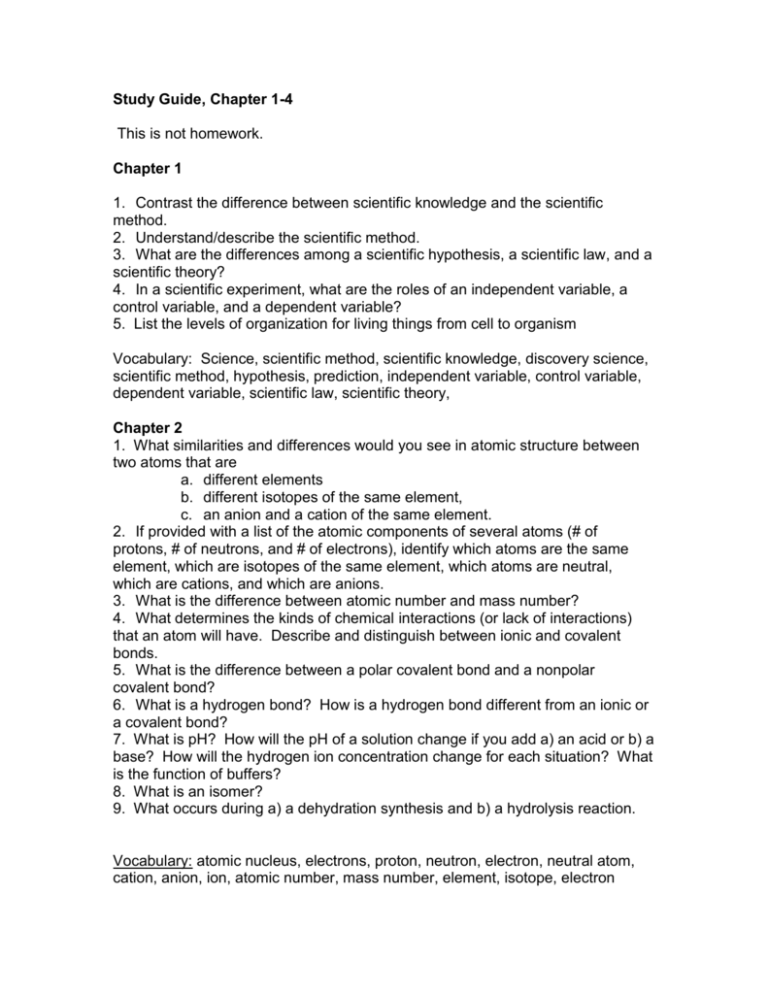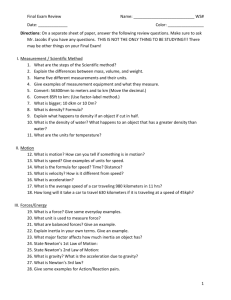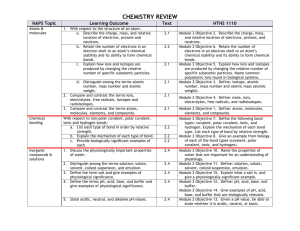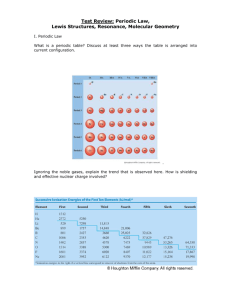Study Guide, Chapter 1-4
advertisement

Study Guide, Chapter 1-4 This is not homework. Chapter 1 1. Contrast the difference between scientific knowledge and the scientific method. 2. Understand/describe the scientific method. 3. What are the differences among a scientific hypothesis, a scientific law, and a scientific theory? 4. In a scientific experiment, what are the roles of an independent variable, a control variable, and a dependent variable? 5. List the levels of organization for living things from cell to organism Vocabulary: Science, scientific method, scientific knowledge, discovery science, scientific method, hypothesis, prediction, independent variable, control variable, dependent variable, scientific law, scientific theory, Chapter 2 1. What similarities and differences would you see in atomic structure between two atoms that are a. different elements b. different isotopes of the same element, c. an anion and a cation of the same element. 2. If provided with a list of the atomic components of several atoms (# of protons, # of neutrons, and # of electrons), identify which atoms are the same element, which are isotopes of the same element, which atoms are neutral, which are cations, and which are anions. 3. What is the difference between atomic number and mass number? 4. What determines the kinds of chemical interactions (or lack of interactions) that an atom will have. Describe and distinguish between ionic and covalent bonds. 5. What is the difference between a polar covalent bond and a nonpolar covalent bond? 6. What is a hydrogen bond? How is a hydrogen bond different from an ionic or a covalent bond? 7. What is pH? How will the pH of a solution change if you add a) an acid or b) a base? How will the hydrogen ion concentration change for each situation? What is the function of buffers? 8. What is an isomer? 9. What occurs during a) a dehydration synthesis and b) a hydrolysis reaction. Vocabulary: atomic nucleus, electrons, proton, neutron, electron, neutral atom, cation, anion, ion, atomic number, mass number, element, isotope, electron energy level, ionic bond, covalent bond, molecule, compound, electronegativity, nonpolar covalent bond, polar covalent bond, hydrogen bond Chapter 3 1. Be able to identify from a chemical structure diagram: a typical monosaccharide (glucose), a typical saturated fatty acid, a typical unsaturated fatty acid, a typical triaclyglyceride, a typical phospholipid, a typical steroid (cholesterol), a typical amino acid, a typical nucleotide. 2. What are the functions/roles in organisms of a) monosaccharides, b) disaccharides, c) polysaccharides, d) fatty acids, e) triacyglycerides, f) phospholipids, g) cholesterol, h) steroid hormones, i) proteins, j) adenosine phosphates, k) RNA, and l) DNA? 3. What is responsible for lactose intolerance and why is it a health problem? 4. What makes each of the 20 common amino acids different? Why is it important that your diet include the 8 essential amino acids each day? 5. What factors determine the three-dimensional shape of a protein. In what way does sickle cell anemia illustrate the importance of primary structure in determining the final three-dimensional shape of a protein and its proper function? How is protein shape in certain brain proteins influenced in the case of cows infected with mad cow disease (BSE)? 6. What three differences distinguish RNA from DNA? 7. In general terms, what steps are involved when a cell synthesizes a specific protein? Vocabulary: macromolecule, monomer, polymer, dehydration reaction, carbohydrate, monosaccharide, disaccharide, polysaccharide, lactose, lactase, lipid, fatty acid, saturated fatty acid, unsaturated fatty acid, trans fatty acid, triaclyglyceride, phospholipid, steroid, cholesterol, hormone, amino acid, R group, essential amino acid, polypeptide, protein, nucleotide, nitrogen base, RNA, DNA, ATP, rRNA, mRNA, tRNA, DNA, gene, transcription, translation. Chapter 4 1. How are prokaryote cells different from eukaryote cells? 2. How are animal cells different from plant cells? 3. What limits cell size? 4. What are the roles of a) ribosome, b) smooth endoplasmic reticulum, c) rough endoplasmic reticulum, d) golgi apparatus, e) lysosome, f) nucleus, g) vacuoles, h) peroxisomes, i) mitochondria, j) chloroplasts, k) microfilaments, l) microtubules, and m) intermediate filaments in the cell 5. Know the components of a membrane and understand their role in its function. 6. What kinds of molecules can pass through a membrane without the assistance of a transmembrane protein? What kinds of molecules cannot pass through a membrane without the assistance of a transmembrane protein? 7. Describe diffusion. What factors influence differences in diffusion rates? 8. Describe osmosis and understand the net movement of water for cells experiencing a) isotonic, b) hypertonic, and c) hypotonic conditions. 9. Contrast active transport and facilitated diffusion. 10. What process do cells use to move large quantities a) into and b) out of a cell, past the cell membrane? Vocabulary: cell membrane, prokaryote cell, eukaryote cell, cell wall, ribosome, smooth endoplasmic reticulum, rough endoplasmic reticulum, golgi apparatus, lysosome, nucleus, chromosome, nucleolus, vacuole, peroxisome, mitochondrion, chloroplast, microfilament, microtubule, intermediate filament.cell membrane, fluid mosaic model, selectively permeable, diffusion, osmosis, isotonic, hypertonic, hypotonic, passive transport, facilitated diffusion, exocytosis, phagocytosis








